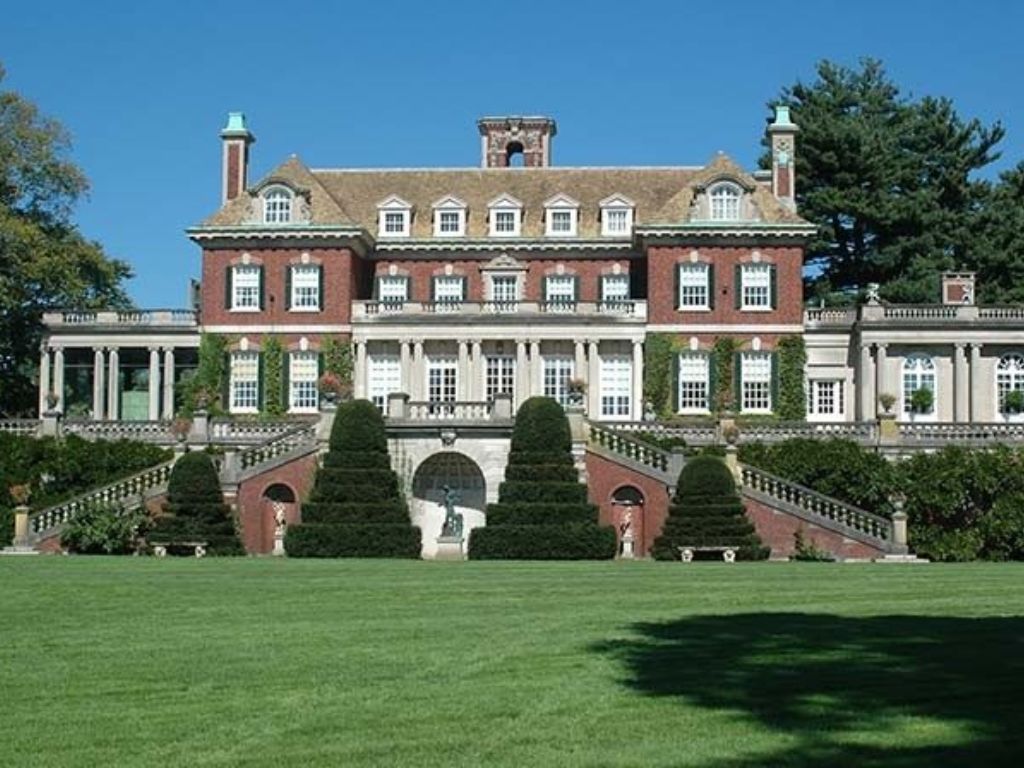At the turn of the last century until well into the 1930s, the undulating landscape of Long Island’s north shore was the favoured retreat of New York’s elite. Vast swathes of prime coastal land were bought up by famous East Coast families and industrialists, including J.P Morgan, F.W Woolworth, the Vanderbilts, Astors and Whitneys, who built grand country estates with their untaxed millions. These came to define the opulence of the Gilded Age and the Roaring Twenties, earning the area its ‘Gold Coast’ moniker.

With money no object, they employed the most accomplished and influential architects and landscape gardeners to construct lavish mansions and formal grounds, creating the high society playground personified in F. Scott Fitzgerald’s masterpiece The Great Gatsby. His fictional ‘West Egg’ and ‘East Egg’ were thinly-disguised versions of, respectively, the north shore villages of Kings Point and Sands Point, and the polo matches, garden parties and cocktail soirées depicted in the novel – not to mention the intrigue, gossip and scandal – were heavily influenced by the privileged Gold Coast lifestyle of the time.
Although the mansions numbered in their hundreds, maintenance costs, increasing taxes, and the Great Depression sent a jolt of reality through the charmed lives of these notable few, and post-World War Two many were sold to developers, or abandoned and left to ruin. A not-insignificant handful, however, have been meticulously restored and maintained, offering an absorbing insight into a bygone era – a time of carefree living and uninhibited wealth.
We’ve singled out of a few of our favourite remaining mansions and estates for a closer look…
Old Westbury Gardens
Built in the early 20th century by financier John S. Phipps, Old Westbury Gardens is probably the grandest, the most well-known and the best preserved of all the remaining Gold Coast estates. Phipps wanted a Charles II-style manor house to make his English wife feel at home, so enlisted the skills of British artist George A. Crawley, whose stately design would go on to star in many Hollywood movies including North by Northwest, Love Story and The Age of Innocence.
The three-storey Westbury House mansion remains virtually untouched; full of antiques, original furniture, personal items and decorative works of art. Outside, the English-style country gardens are widely considered the most beautiful of their type in North America and include more than 150 acres of formal lawns, tree-lined walks, lakeside trails, a walled garden, palm house, rose garden, boating pond, picnic area, reflecting pool, and a children’s playhouse and log cabin. Special events are held here in the summer season, including costume exhibitions, big band concerts and recitals by Juillard conservatory students.
The house and gardens are open from late April until October, daily (but closed Tuesdays) from 10am – 5pm. Self or guided tours are available.
Old Westbury Gardens, 71 Old Westbury Road, Old Westbury, NY 11568
Coe Hall and Planting Fields Arboretum
Built in 1921, Coe Hall is the 65-room Tudor Revival-style mansion sitting within the grounds of Planting Fields – now Planting Fields Arboretum State Historic Park – and was the former home of insurance magnate and philanthropist William Robertson Coe and his Standard Oil heiress wife Mai Rogers Coe. Despite the rather foreboding Elizabethan interior – all dark wood panelling, carved stone and stained glass windows – the house manages to retain an air of frivolity and fun, evidenced by quirky family photos and ingenious Prohibition-busting bar, secretly hidden behind a wall in the parlour. William Coe’s love of the American wild west is also brought to life in an extravagant room decked out to remind him of his Cody, Wyoming ranch (which he purchased from William ‘Buffalo Bill’ Cody), complete with hand-painted mural depicting scenes of elk, bison and horse-riding Native Americans.
The sprawling 409-acre estate was deeded to the State of New York by William Coe in 1949, and is run today as a non-profit educational foundation. The rolling lawns and formal gardens are enhanced by various seasonal displays of orchids, cacti, camellias and tropical palms, and there’s a teahouse, Italian garden with shimmering blue pool, and hundreds of rare trees.
Planting Fields is open daily from 9am to 5pm. Coe Hall is open for self-guided visits and tours between 1st April and Labor Day (first Monday in September).
Planting Fields Arboretum State Historic Park, 1395 Planting Fields Road, Oyster Bay, NY 11771
The Vanderbilt Mansion and Planetarium
The Vanderbilt mansion was built in three stages between 1910–1936 in a very different style to the other Gold Coast homes. Willie Vanderbilt was an early 20th century petrol head who had already built his own private highway across much of Long Island, which he used for popular but controversial car races. He had the 24-room Spanish Revival-style mansion designed by the team of architects responsible for Grand Central Terminal, and filled it with rare ethnographic art, trophies, memorabilia and marine specimens which reflected his passions for yachting, fast cars, natural history and anthropology.
After Willie died in 1944, the estate was bequeathed to Suffolk County, New York, on the proviso that it be used as a museum for his eclectic collections. The complex now includes the mansion itself, along with a marine museum, curator’s cottage, boathouse, seaplane hangar and one of the USA’s most advanced planetariums.
Opening hours vary throughout the year – check the website for details.
Vanderbilt Museum,180 Little Neck Road, Centerport, New York 11721
And the best of the rest
Sagamore Hill was the 1885-built mansion of Theodore Roosevelt, which ended up serving as the summer White House during his time in office. Sands Point Preserve is another of the large estates that has since been reborn as a nature reserve. The mansions here include Hempstead House, Castle Gould and Falaise.
Castle-style Hempstead House is widely regarded as the most lavish of all the Gold Coast mansions, owned by railroad tycoon Jay Gould and then the philanthropist Daniel Guggenheim, before eventually being sold to the Navy. Falaise, based on the design of a French Normandy chateau, is one of the few remaining fully intact houses, and directly overlooks Long Island Sound.
Essentials
Getting around: The best way to visit the Long Island Gold Coast is undoubtedly by car. The mansions are fairly spread out, and there are no public transport connections between them. However, it is perfectly possible to visit selected mansions on a day trip from Manhattan by train and taxi from NYC’s Penn Station, as the Long Island Rail Road serves this area well. For example, a direct train from Penn Station to Westbury takes around 45 minutes, where taxis are available for the 2.5 mile journey to Old Westbury Gardens. Alternatively, Planting Fields is just two miles from Oyster Bay station, which is a 1hr 25 minute train ride from the city.
JFK is probably the most logical place to pick up a hire car – you’re less than an hour from the Gold Coast from here. Remember that Virgin Atlantic Flying Club members can earn miles with our car rental partners.
Where to stay: One of the best places to stay in the area is Glen Cove Mansion, once one of the Gold Coast’s finest country estates. The majority of the 187 guestrooms are in a modern extension at the rear so you don’t quite feel as though you’re living in another era, but the dining room, bar, library and terrace are all housed within the beautiful main building. Facilities include good-sized indoor and outdoor pools, basketball and racquetball courts and a fitness centre.
Other options include the Inn at Fox Hollow and the Viana Hotel and Spa.
Out and about: Be aware that this is a fairly suburban part of Long Island. Once the mansions changed hands and the developers moved in, huge tracts of land were filled in with upscale residential housing and shopping centres. It’s fair to say that most of the beauty lies within the gates of the mansions themselves, rather than the area that surrounds them. That said, there are winding forest-lined roads and real pockets of serenity – particularly around leafy Locust Valley and the watery surroundings of Mill Neck, Centre Island and Oyster Bay Cove.
Where to eat: Grab a cosy wooden booth at Buckram Stables Café in Locust Valley for French toast, pancakes, salads, sandwiches and burgers, or head to lively Port Washington for a more sophisticated choice of dining options. Louie’s Oyster Bar and Grille has been voted the best seafood restaurant in Long Island five years in a row – make sure you ask for a table on the outside terrace overlooking the bobbing boats of Manhasset Bay. Similar fare is on the menu at LaMotta’s Waterside Restaurant just across the harbour. Not a seafood lover? Check out Wild Honey on Main for high quality classic North American cooking in a relaxed, intimate setting.
Written by Maxine Sheppard



